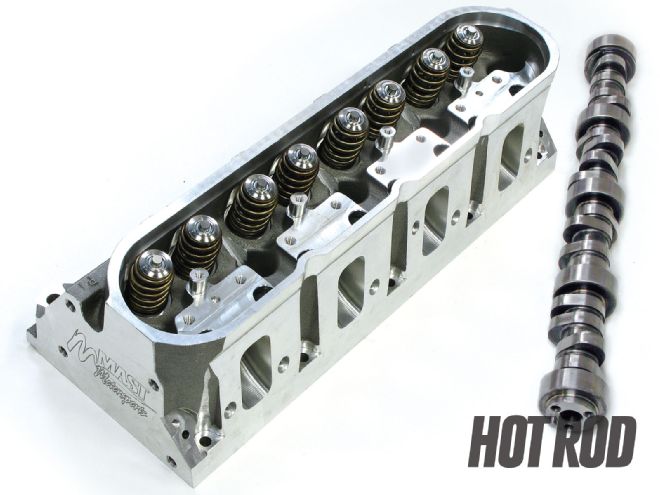
The Premise
“Once you’ve put headers and a bigger cam into a 2010 Camaro, short of bolting on a blower or building a stroker, the only thing left to do is to install better cylinder heads.” Those were the words of Horace Mast of Mast Motorsports. The quote came in a pitch for his head and cam package, so we tried it out. The results are relevant for anyone with a GM 6.2L LS3 engine.
The Stuff
The cam kit we tested was PN 963-102, which includes the hydraulic roller cam and matching springs for $680. The cam specs are 225/231 degrees of duration at 0.050, 0.602/0.607-inch lift, and a lobe-separation angle of 115 degrees.
Mast’s LS3 head castings are available in three different trim levels for small-, medium-, and large-bore motors. We tested the medium-bore heads (PN 510-302) with 256/89cc ports and 2.165/1.600 valves. Prices for an assembled set—which includes factory GM rocker arms, Mast rocker stands, and Mast springs—start at $3,600. The valve angles are flattened from 15 degrees stock to 11 in the Mast heads, but they’re compatible with stock pistons. These heads are also available for aftermarket six-bolt blocks.
The Test
The dyno mule was a 6.2L LS3, stock other than long-tube headers. We added the cam first, using Mast springs on the stock heads, and the heads second. The stock chamber size is 70 cc, and the Mast ones are advertised at 69 cc, so there may have been a very minute increase in compression ratio.
The testing was done on Mast’s SuperFlow 902 engine dyno. Mast prefers step testing, in which the engine pauses at each rpm point and stabilizes before accelerating to the next data point. This is different from the more commonly used acceleration test and tends to produce slightly higher power.
The Results
Stock, the LS3 produced 469 hp at 5,800 rpm and 465 lb-ft at 4,800 rpm. With just the Mast cam, peak power increased to 533 hp, a gain of 64 hp, and the rpm at peak increased by 600 rpm, to 6,400. Torque improved to 480 lb-ft at a higher 5,400 rpm. Not bad! Next, we bolted on the Mast heads and discovered they require 8.150-inch pushrods, which are longer than stock. The heads moved the numbers to 568 hp at 6,400 and 507 lb-ft at 5,400 rpm—gains of 35 hp and 27 lb-ft with no change to the peak rpm points.
Conclusions
The Mast camshaft gives up torque below 3,200 rpm, but on average from 2,000 to 6,800 rpm, it’s far stronger than stock. The larger cylinder heads—which, in bench racing theory, make less low end—made up for the torque losses of the cam, matching the stock torque numbers through 3,200 rpm, then climbing to a curve that destroys the stock setup. The 568 hp and 507 lb-ft make for an easy mid-11-second dragstrip pass, even in a 3,900-pound car.
Bottom Line
You get 100 hp for around $4,000, but to see that gain in the car, you’ll also need long-tube headers, a cold-air kit, and a custom tune.
Dyno Results: LS3 Bolt-Ons
Stock Cam Heads RPM HP TQ HP TQ HP TQ 2,000 135 355 124 326 133 346 2,200 147 355 132 321 147 360 2,400 167 369 156 342 165 364 2,600 188 384 182 362 189 376 2,800 209 395 198 372 220 401 3,000 226 399 222 390 233 408 3,200 244 404 239 403 246 416 3,400 263 410 263 413 271 424 3,600 288 423 285 422 292 431 3,800 310 433 303 423 312 431 4,000 330 439 325 424 346 447 4,200 356 448 364 446 391 479 4,400 380 457 382 456 407 486 4,600 400 460 406 465 425 493 4,800 422 465 435 471 455 495 5,000 435 462 463 477 475 499 5,200 447 455 473 478 488 502 5,400 460 450 490 480 518 507 5,600 467 441 508 476 539 504 5,800 469 427 520 466 554 495 6,000 446 410 527 462 559 489 6,200 446 397 530 449 562 483 6,400 464 383 533 440 568 469 6,600 448 358 531 426 563 448 6,800 N/A N/A N/A 575 7,000 N/A N/A N/A 577 Avg: 339 415 358 425 377 448